
First log cabin
I shall never forget the last day on the road [traveling by covered wagon and two oxen]. We traveled until after dark to get to the cabin father had told us about, which was to be our home. We could not see what it looked like after dark as we had only a lantern as our main light and that a tin one with holes punched in it for the light of a tallow candle to come out. We were glad to get to our new home and not have to camp on the prairie any more. We took possession of the house and by the light of the lantern described, took our carpets and quilts inside, made our beds and lay down for the night without any supper except a bit we ate on the road.
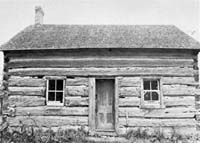
What did we see in the morning? A log cabin about eighteen feet square with a puncheon floor. That is, logs hewed on one side and notched on the under side to fit the cross poles. It was not tight by any means. There were cracks in it. When brother Frank and I rolled over in the morning, Frank said, “Look down this crack. If there is not a hen’s nest under the floor.” It had been left there by the family who moved out. The walls of this house were made out of all kinds of logs – oak, hickory, linden, buckeye, etc. The surface of some of those soft wood logs looked like a menagerie for all kind of pictures had been made on them with charcoal by those who had lived there before. The roof was made of ridge poles laid across and then covered with clapboards. These clapboards were split out of oak logs about three-fourths of an inch thick and nearly three feet long and sometimes held in place by poles, but generally nailed with square nails about number ten. These boards would warp and twist with the rain and snow and when the blizzards came in the winter, the snow would sift through the cracks and come down through the loft right on our heads. The loft was made of loose boards laid on hewed poles at the top of the square. Frank and I would go up and sweep the snow into buckets and hand them down to father through the scuttle hole or else it would melt and come down all over the house. All cabins had a fireplace. Ours was made of stone part way up and then of notched logs and sods from the prairie on the inside. Sometimes the smoke would go up the chimney and sometimes come down, depending on the wind. There was just one door in that house and two small windows, a log or two cut out. All cracks in between the logs were filled with mud for lime was hard to get, but some people did make lime from the lime rock. Father did not like the looks of our chimney, nor did he think it was safe enough to pass through our first winter. So he took the ox team to the timber, dug out rocks, and made a new one.
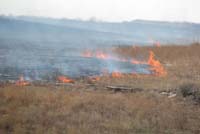
Prairie Fires
I remember one afternoon while we were digging we saw dense smoke coming from the southwest (that was the prevailing way the wind came from). It was in the fall of the year [1855] and father said we had better go and plow out a fire land to save our house and the rails we had around a little patch of ground; that is, plow a few furrows around on each side of a strip of land forty or fifty feet wide. Then burn out the land between. This would make it safe from the great prairie fire. This had to be done before the fire came for I have seen the fire go almost as fast as a horse could run. To see a prairie fire after night was one of the greatest of sights; the whole prairie would be a burning mass. Sometimes when the prairies escaped being burnt off in the fall they would get burned over in the spring, after the prairie hens had commenced laying their eggs in the prairie grass. To see the prairie chickens by the hundreds, their nests burned over, and the eggs partly baked, made another great sight for me. Another fine sight was when the prairie grass would start up in the spring of the year. After the dry grass was burned off, the green grass was a solid mass interspersed with wild flowers of every kind in full bloom from June to the last of August. No artificial park or flower garden compares with it either in size or grandeur. That was before the grass and flowers were tramped out by the stock.
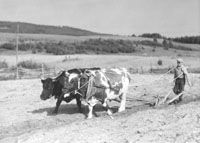
Farming in the 1850s
Farming was done on a very small scale in those days. The first year or two we had only a few acres under cultivation. The prairie was hard to plow the first time, the sod being so tough. We plowed with two yoke of oxen and a small sod plow only thirteen or fourteen inches wide. We had only about twenty-five acres the first year but hardly any weeds. Planting corn was all done by hand. First we marked out the ground crossways, if we wanted it rowed both ways. This was mostly done with a horse and single shovel plow at first, but later, when we got wiser, with a three-wheel marker and team. The marker had a seat for the driver to ride on and side markers to drive by. The planting was done with a horse and single shovel plow. One man to make the furrow, one boy to drop the corn, another man with a one-horse plow to cover the corn. This was the way we planted for eight or nine years, or until the last year of the Civil War, when we bought a two-horse corn planter similar to that in use today [1924]. We bought almost the first one in the neighborhood. There was no rope or wire to the first planters. A boy or man sat on it and dropped by hand and must hit the marks made crossways.
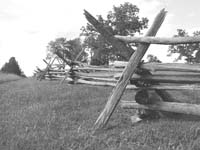
Fencing
The first year we were in Iowa all fencing had to be done with rails; not much fencing was done with boards until up into the 1870s. We went to the timber and split the rails and made a worm fence, as it was called. There was just enough worm or crook in it so the fence would stand, then stakes were set in each panel slanting against the fence which was generally six rails high with a block under each corner. Two heavy rails were put onto the stakes that had been set, making the fence eight rails high and about sixteen rails to the rod besides the four stakes making twenty with them. It was quite a job to fence forty acres that way. The fields had all to be hog tight, cattle strong, and horse high, for all kinds of stock were running on the prairie. I well remember our first field of about forty acres. Father would make enough rails through the winter so we could add ten or fifteen rods on each end and move one side out to meet the new ends. I do not know how many times that side had to be moved each spring until we had eighty or a hundred acres fenced. We nearly always had a little patch of spring wheat and sometimes it would get up high enough for the stock to eat before we would get the fence moved. Then we would have to herd the stock off while the fence was being moved. Someone had to be on guard on the Sabbath and every day until the field was enclosed.
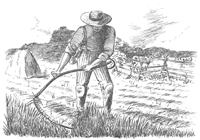
Haying
Haying was another slow job in those days. There were no mowing machines and all the hay we had must be cut with the scythe on the prairie, for the prairie grass was the only thing to make hay out of. We not only had to make enough for feed, but our stables and sheds were banked up and covered with slough grass hay. This had to be hauled in soon after it was make or the cattle would come along and scatter the shocks all over the ground. What small grain we raised had to be cut by hand with a cradle. Perhaps you never saw one. This was the way farming was carried on until the commencement of the Civil War in 1861. Then men and boys were taken in the army (for boys were enlisted as young as fourteen years of age according to statistics 14,000 were taken at that age). Since many of these men were taken from the farms, some means had to be invented to take the place of men if the farmers were to raise enough for the army and the folks at home. The first invention I remember was the corn planter I have described. The next was the mowing machine and reaper. We bought the first planter the last year of the war and also the first mower. The mower was a little four-foot Buckeye, the first in the neighborhood. It was a great relief to throw down the scythe. Our mower was in much demand. We not only used it ourselves but the neighbors would come and beg us to mow for them and they would pay us for it. So that mower was kept busy all through the haying season which lasted several weeks in the prairie grass. The next improvement was the self-binder. I should have said the first grain machine. We had to bind by hand the bunches of grain as it dropped them behind it, and this was the hardest work I ever tried to do.
Civil War Draft – and new house
You may ask how long we lived in the log cabin. Nine years or until the last year of the was when father was drafted into the Army. He had been wanting to volunteer and talked about volunteering in every company that was going from Warren County, but mother would say, “Now, David, you are not going and leave us in this old log cabin. Suppose you should never come back?” Then he would give it up for the time being. But he would say, “There will be a draft of men to go to the army perhaps and I would have choice of company and regiment.” Sure enough, the draft did come in the fall of 1864 and father was one of the men drafted and he was delighted to think he was going to have a hand in putting down the rebellion and to demonstrate his patriotism. As soon as he received notice of his being drafted he went right to Des Moines to see the Adjutant General (who was the father of Dr. Baker of Indianola who died two or three years ago) and said to him, “You have notified me to appear within thirty days. I have not waited the thirty days to appear, but have come to ask for another thirty days.” He then went on to explain what kind of house the family was living in and that he thought he could build a good deal better one in the sixty days. General Baker, appreciating his patriotism, told him to report in sixty days. He came right home and commenced hauling logs to the saw mill and engaged carpenters to build a new house made of all native lumber, oak roof, floors, siding, lining, and all. It is still standing, the first building south of the square-topped house where sister Sadie lived and where father and mother both passed their last years.
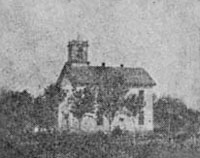
Schools 1866 – Teaching
When we came to Iowa in 1855 the schools were hardly in running order. There were few buildings and very few teachers. As my stepmother was a graduate of Amherst College, Massachusetts, she would give brother Frank and me daily lessons, for there was no school for us to go to. For two winters the neighbor boys would come to our house and she would give them lessons at night. Afterwards she taught a subscription school. Our first schoolhouse was built in 1858, a small one, weather-boarded up and down like a barn with wide boards and lined with linden timber. One of my first teachers was Cynthia Bundy Barnes, who now lives in Indianola. Sometimes we would have only three months of school in the year. Afterwards there was six months of school, but we did not have a very good chance for schooling. When the Civil War days came, it made it more difficult, for many boys went into the Army before their school days were over and those left at home had too much work to do. A few who had the privilege of attending the school (after the war was over) at Indianola in a building we called the Blue Bird (because it was made of brick and painted blue) got a little better education. It was a blessing to the county for it was more like an academy. You could enter any grade on up to the highest study. The principal of the Blue Bird, while I attended, was O. H. Baker, who afterwards was sent from the United States as minister to Australia. Reverend S. M. Vernon was another principal while I attended. That was before there was any railroad in the town. This was in 1866, my first year. The next year, 1867, the courthouse was commenced. That was twenty-one years after the county was organized and three years after the town of Indianola was incorporated. I well remember a great many of the students who attended when I did – John Henderson, William Berry, Charley Bane, Brenton Dudley, Ben Noble, Talbot brothers, and a host of others. My first ballot was cast for Ulysses S. Grant for President of the United States. That was in the year 1868. The same year I was elected township clerk, an office I did not want but some old men induced me to take it. At the very next election the township board challenged ever so many voters and I had to make them testify by the uplifted hand to all the questions the law prescribed; how old they were, how long in the county, etc. My next venture was the same year I became a voter. I contracted to teach a term of school and then kept teaching parts of five years. I was twenty years on the old homestead in central Otter Township.
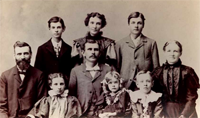
Married Life
My wife and I took up our abode one mile and a half south of Milo in 1875. There was no Milo then. No railroad. No church. We attended church at Lacona the first five years. Then a part of the membership of the Lacona church who were north of Lacona toward where Milo is, withdrew from the Lacona church and organized a little band of seventeen members in what was then called Goode’s Chapel. The next year we built our church building, the first one in Milo. At that organization meeting I was elected one of the elders of the church. That was in the summer of 1880. Also I was elected teacher of the boys’ class – boys whose ages ran from fifteen to eighteen. Those positions I held for ten years or until we reorganized in the year 1890, changing from the United Presbyterian to the Presbyterian. I was again elected an elder along with W. C. Wilson, Walter Waugh, Harmon Shrader, James Gilbert, and James Amsberry. I was also elected teacher of the Bible class, which positions I have held up to the present, 1924, making forty-four years as elder in the church and the same length of time as teacher, and thirty-three years as teach of the Bible class. There are those in the class today who were charter members of the church.
William Porter Nutting
|
